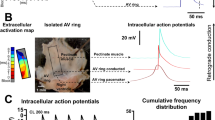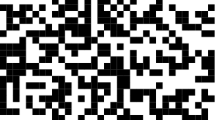Summary
Rapid ventricular response during episodes of supraventricular tachycardia are often followed, on abrupt cessation of the tachycardia, by prolonged pauses terminated by a sluggish and sometimes erratic escape of a supraventricular pacemaker. Such chronotropic-dromotropic paradoxes are readily reproduced in the animal laboratory following elimination of the sinus node and bilateral decentralization of the stellate ganglia and vagi. This study examined whether left stellate stimulation (0.5, 1, 2, 4, 8 and 16 Hz) or lack thereof differentially affected AV junctional automaticity and AV conduction. In the absence of any sympathetic neural activity (maximal sympathetic deficit), the AV junctional rate averaged a mere 22±2 percent of its peak performance, whereas under the same conditions, anterograde AV conduction averaged 73±5 percent and retrograde VA conduction 56 ±13 percent of their respective peak performances. On comparing the response curve (normalized responses) for AV junctional automaticity with that obtained for anterograde AV conduction the differences were significant at all frequencies between 0 and 4 Hz. Retrograde VA conduction (as assessed by the fastest ventricular pacing rate still conducted 1∶1 to the atria) was always significantly less than anterograde AV conduction (as assessed by the fastest atrial pacing still conducted 1∶1 to the ventricles). These results indicate that AV junctional automaticity is considerably more affected by sympathetic deficit than are either anterograde or retrograde AV conduction. In other words, AV junctional automaticity is far more dependent upon sympathetic input than AV conduction. While sympathetic influence is critical to the escape and maintenance of AV junctional automaticity both anterograde and retrograde AV conduction are remarkably resilient even under conditions of severe sympathetic deficit.
Similar content being viewed by others
References
Blair SM, Davies F (1935) Observations on the conducting system of the heart. J Anat 69:303–324
Bertrand ME, Leblanche JM, Rousseau MF, Warembourg HH, Stankowtak C, Soots G (1980) Surgical treatment of variant angina: use of plexectomy with aortocoronary bypass. Circulation 61:877–882
Bertrand ME, Leblanche JM, Tilmant PY (1981) Treatment of Prinzmetal's variant angina: role of medical treatment with Nifedipine and surgical coronary revascularization combined with plexectomy. Am J Cardiol 47:174–178
Copenhaver WM, Truex RC (1953) Histology of the atrial portion of the cardiac conduction system in man and other mammals. Anat Rec 114:601–625
Eyster JAE, Meek WJ (1916) Experiments on the origin and conduction of the cardiac impulse. VI. Conduction of the excitation from sinoauricular node to the right auricle and auriculoventricular node. Arch Intern Med 18:775–799
Froggatt P, James TN (1973) Sudden unexpected death in infants. Evidence on a lethal cardiac arrhythmia. Ulster Med J 52:136–152
Geis WP, Tatooles CJ, Priola DV, Friedman WF (1975) Factors influencing neurohumoral control of the heart in the newborn dog. Am J Physiol 228:1685–1689
Hayashi K (1962) An electron microscope study on the conduction system of the cow heart. Jap Circ J 26:765–842
Hayashi S (1971) Electron microscopy of the heart conduction system of the dog. Arch Histologicum Jap 33:66–86
James TN (1961) Anatomy of the human sinus node. Anat Rec 141:109–139
James TN (1962) Anatomy of the sinus node of the dog. Anat Rec 143:251–265
James TN, Sherf L (1969) Ultrastructure of the human atrioventricular node. Circulation 37:1049–1070
James TN, Sherf L, Fine G, Morales AR Comparative ultrastructure of the sinus node in man and dog. Circulation 34: 139–163
Jones SB, Euler DE, Hardie EL, Randall WC, Brynjolfsson G (1978) Comparison of SA nodal and subsidiary atrial pacemaker function and location in the dog. Am J Physiol 234:H471-H476
Kawamura K (1961) Electron microscope studies on the cardiac conduction system of the dog. II. The sinoatrial and atrioventricular nodes. Jap Circ J 25:973–1013
Kliks BR, Burgess MJ, Abildskov JA (1975) Influence of sympathetic tone on ventricular fibrillation threshold during experimental coronary occlusion. Am J Cardiol 36:45–49
Lazzara R, Scherlag BJ, Robinson MJ, Samet P (1973) Selective in situ parasympathetic control of the canine sinoatrial and atrioventricular nodes. Circ Res 32:393–401
Levy MN, Martin PJ (1979) Neural control of the hear. In: Berne RM, Sperelakis N, Geiger SR (eds) Handbook of Physiology, Section 2, The Cardiovascular System, Vol 1, The Heart. Bethesda Maryland-American Physiological Society, 581–620
Malliani A, Schwartz PJ, Zanchetti A (1980) Neural mechanisms in life-threatening arrhythmias. Am Heart J 100:705–715
Pollack GH (1977) Cardiac pacemaking: An obligatory role of catecholamines? Science 196:731–738
Randall WC (1984) Selective autonomic innervation of the heart. In: Randall WC (ed) Nervous Control of Cardiovascular Function; Chap 3. Oxford University Press, New York, 46–47
Randall WC, Kaye MP, Hageman GR, Jacobs HJ, Euler DE, Wehrmacher WH (1976) Cardiac dysrhythmias in the conscious dog following surgically induced autonomic imbalance. Am J Cardiol 38:178–183
Randall WC, Talano J, Kaye MP, Euler D, Jones S, Brynjolfsson G (1978) Cardiac pacemakers in absence of the SA node: responses to exercise and autonomic blockade. Am J Physiol 234:H465-H470
Randall WC, Wehrmacher WH, Jones SB (1981) Hierarchy of supraventricular pacemakers. J Thorac Cardiovasc Surg 82:797–800
Rasheysky N (1960) Mathematical biophysics: Physico-mathematical foundations of biology. New York, Dover, vol II, 3rd division
Rozanski GJ, Lipsius SL, Randall WC (1983) Functional characteristics of sinoatrial and subsidiary pacemaker activity in the canine right atrium. Circulation 67:1378–1387
Schwartz PJ (1976) Cardiac sympathetic innervation and the sudden infant death syndrome. A possible pathogenic link. Am J Med 60:167–172
Schwartz PJ (1984) Sympathetic imbalance and cardiac arrhythmias. In: Randall WC (ed) Nervous Control of Cardiovascular Function. Chap 10. Oxford University Press, New York Oxford, 225–252
Schwartz PJ, Motolese M, Pollavini G, Malliani A, Bartorelli C, Zanchetti A (1985) Surgical and pharmacological antiadrenergic interventions in the prevention of sudden death after a first myocardial infarction. Circulation 72:III-358
Schwartz PJ, Stone HL (1980) Left stellectomy in the prevention of ventricular fibrillation caused by acute myocardial ischemia in conscious dogs with anterior myocardial infarction. Circulation 62:1256–1265
Schwartz PJ, Stone HL (1982) The role of the autonomic nervous system in sudden coronary death. Ann NY Acad Sci 382:162–181
Snedecor GW, Cochran WG (1980) Statistical methods. Iowa State University Press, Ames, Iowa, 215–237 and 365–392
Thaemert JC (1970) Atrioventricular node innervation in ultrastructural three dimensions. Am J Anat 128:239–264
Thaemert JC (1973) Fine structure of the atrioventricular node as viewed in serial sections. Am J Anat 136:43–66
Thomas JX Jr, Randall WC (1983) Autonomic influences on atrioventricular conduction in conscious dogs. Am J Cardiol 244:H102-H108
Urthaler F, Katholi CR, Macy J, James TN (1973) Mathematical relationship between automaticity of the sinus node and the AV junction. Am Heart J 86:189–195
Urthaler F, Katholi CR, Macy J Jr, James TN (1974) Electrophysiological and mathematical characteristics of the escape rhythm during complete AV block. Cardiovasc Res 8:173–186
Urthaler F, Kawamura K, James TN (1978) The anatomical basis for cardiac rhythm and conduction. In: Andreoli TE, Hoffman BF, Fanestil DD (eds) Physiology of Membrane Disorders. Plenum Press, 831–875
Urthaler F, Millar K, Burgess MJ, Abildskov JA, James TN (1973) Comparative dependence on adrenergic neural tone by automaticity in the sinus node and in the AV junction. J Pharmacol Exp Ther 187:269–279
Verrier RL, Lown B (1981) Autonomic nervous system and malignant cardiac arrhythmias. In: Wiener H, Hofer MA, Stunkard AJ (eds) Brain Behaviour and Bodily Disease. Raven Press, 273–291
Wallick DW, Felder D, Levy MN (1978) Autonomic control of pacemaker activity in the atrioventricular junction of the dog. Am J Physiol 235:H308-H313
Yamauchi A (1973) Ultrastructure of the innervation of the mammalian heart. In: Challice CE, Viragh S (eds) Ultrastructure of the Mammalian Heart. Academic Press, New York London, 127–178
Yanowitz R, Preston JB, Abildskov JA (1966) Functional distribution of right and left stellate innervation to the ventricles: production of neurogenic electrocardiographic changes by unilateral alteration of sympathetic tone. Circ Res 18:416–428
Author information
Authors and Affiliations
Rights and permissions
About this article
Cite this article
Urthaler, F., Neely, B.H., Hageman, G.R. et al. Differential effects of sympathetic activity on AV junctional automaticity and AV conduction. Basic Res Cardiol 81, 497–507 (1986). https://doi.org/10.1007/BF01907756
Received:
Issue Date:
DOI: https://doi.org/10.1007/BF01907756




